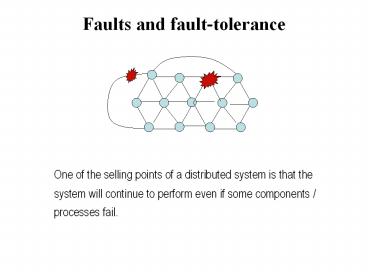Faults and fault-tolerance - PowerPoint PPT Presentation
Title:
Faults and fault-tolerance
Description:
Temporal failure. Security failure. Crash failures. Crash failure is irreversible. ... violated, but not liveness). Eventually. safety property is restored. P. Q ... – PowerPoint PPT presentation
Number of Views:84
Avg rating:3.0/5.0
Title: Faults and fault-tolerance
1
Faults and fault-tolerance
- One of the selling points of a distributed
system is that the system will continue to
perform even if some components / processes fail.
2
Cause and effect
- Study what causes what.
- We view the effect of failures at our level of
abstraction, and then try to mask it, or recover
from it. - Be familiar with the terms MTBF (Mean Time
Between Failures) and MTTR (Mean Time To Repair)
3
Classification of failures
Omission failure
Crash failure
Software failure
Transient failure
Temporal failure
Security failure
Byzantine failure
4
Crash failures
- Crash failure is irreversible. How can we
distinguish between a process that has crashed
and a process that is running very slowly? - In synchronous system, it is easy to detect
crash failure (using heartbeat signals and
timeout), but in asynchronous systems, it is
never accurate. - Some failures may be complex and nasty.
Arbitrary deviation from program execution is a
form of failure that may not be as nice as a
crash. Fail-stop failure is an simple abstraction
that mimics crash failure when program execution
becomes arbitrary. Such implementations help
detect which processor has failed. If a system
cannot tolerate fail-stop failure, then it cannot
tolerate crash.
5
Omission failures
- Message lost in transit. May happen due to
various causes, like - Transmitter malfunction
- Buffer overflow
- Collisions at the MAC layer
- Receiver out of range
6
Transient failure
- (Hardware) Arbitrary perturbation of the global
state. May be induced by power surge, weak
batteries, lightning, radio-frequency
interferences etc. - (Software) Heisenbugs, are a class of temporary
internal faults and are intermittent. They are
essentially permanent faults whose conditions of
activation occur rarely or are not easily
reproducible, so they are harder to detect during
the testing phase. - Over 99 of bugs in IBM DB2 production code are
non-deterministic and transient
7
Byzantine failure
- Anything goes! Includes every conceivable form
of erroneous behavior. - Numerous possible causes. Includes malicious
behaviors (like a process executing a different
program instead of the specified one) too. - Most difficult kind of failure to deal with.
8
Software failures
- Coding error or human error
- Design flaws
- Memory leak
- Incomplete specification (example Y2K)
- Many failures (like crash, omission etc) can be
caused by software bugs too.
9
Specification of faulty behavior
- program example1
- define x boolean (initially x true)
- a, b are messages)
- do S x ? send a specified action
- ? F true ? send b faulty action
- od
a a a a b a a a b b a a a a a a a
10
Fault-tolerance
A system that tolerates failure of type F
- F-intolerant vs F-tolerant systems
- Four types of tolerance
- - Masking
- - Non-masking
- - Fail-safe
- - Graceful degradation
- tolerances
faults
11
Fault-tolerance
- P is the invariant of the
- original fault-free system
- Q represents the worst
- possible behavior of the
- system when failures occur.
- It is called the fault span.
- Q is closed under S or F.
Q
P
12
Fault-tolerance
- Masking tolerance P Q
- (neither safety nor liveness is violated
- Non-masking tolerance P ? Q
- (safety property may be temporarily
- violated, but not liveness). Eventually
- safety property is restored
Q
P































